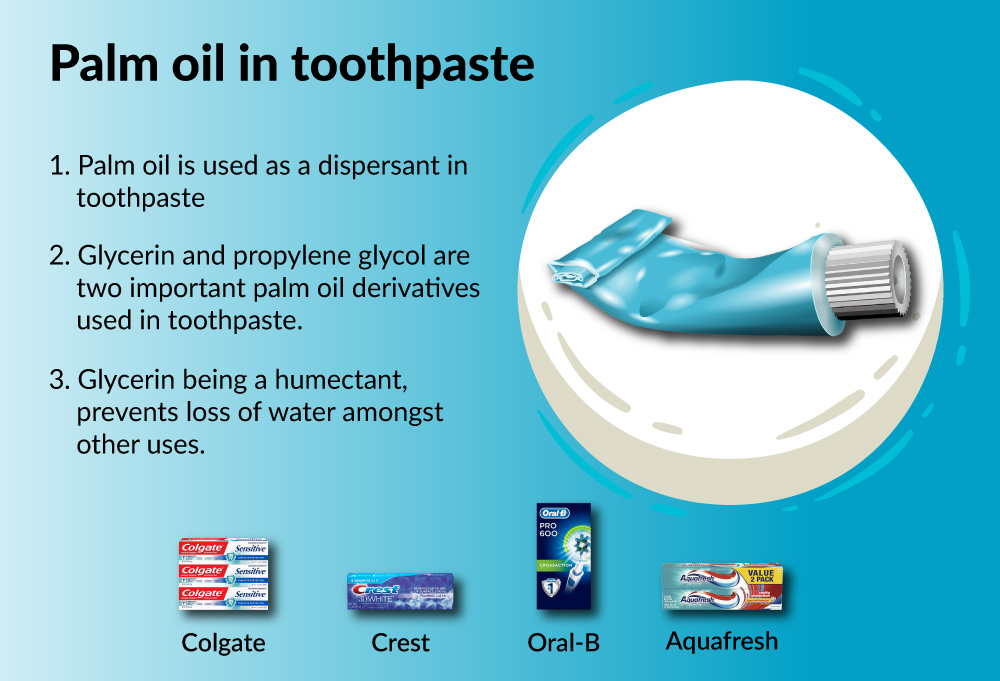Palm oil derivatives with essential functionality in toothpaste
Why palm oil matters? It’s present in most of our personal care products including toothpaste, which affects everyone’s life. Toothpaste keeps our teeth shiny, our gums healthy and our breath fresh. The oral hygiene product that we use every day generally contains palm oil (referring to the relevant palm oil derivatives explained hereafter) for its essential functions.

In toothpaste, palm oil is often used as a dispersant, which is identified by its chemically driven alternate names. The common palm-derived ingredients may include sodium lauryl sulfate (a.k.a lauryl sodium sulphate, lauryl sulphate sodium salt, sodium dodecyl sulphate, sodium n-dodecyl sulphate), glycerin (a.k.a glycerine, glycerol), propylene glycol, sodium methyl cocoyl taurate, sodium lauroyl glutamate, and sodium stearate (sodium salt of stearic acid).
Humectants such as and glycerin and propylene glycol, and synthetic detergents (a mixture of surfactants) are two key palm oil derivatives used in toothpaste’s formulation.
Glycerin, being a humectant, prevents loss of water and subsequent hardening of the product upon exposure to air (to prevent the toothpaste from drying out in the tube). In other words, it gives toothpaste a consistent texture and helps it glide smoothly from the tube. Glycerin itself is a polyol compound in viscous liquid form, which is colourless, odourless, and non-toxic.
Meanwhile, sodium lauryl sulfate is a salt derived from lauryl sulfate to clean the tooth surface and provide a foaming lather. The substance helps separate molecules (by lowering the surface tension, penetrating and loosening surface deposits) as the lather effect comes in handy to disperse stains and build-ups (by emulsifying the oral debris), while binding important toothpaste ingredients together for better cleaning results. Many studies have concluded that sodium lauryl sulfate, when it is rinsed away, is safe for brief use such as brushing teeth, and is not carcinogenic (cancer causing).
Other typical toothpaste components include fluoride (to control plaque, tartar and gum disease), mild abrasives (for cleaning and polishing), flavouring agents (e.g. sweet, minty or fruity flavour), thickening agents/ binders (to prevent separation of solid and liquid ingredients during storage), colouring agents, specialized ingredients (e.g desensitising and whitening agents), preservatives (to prevent bacterial growth on the organic binders and humectants), and water.
A general guideline to the percent composition of different compounds found in toothpaste is published here.
Apart from its unrivalled functionality or versatility, manufacturers prefer palm oil and its derivatives for simple yet practical reasons – it is derived from an oil crop boasting the highest yield with the lowest production cost, and abundantly available.
Major oral care groups (brands) include Colgate-Palmolive (Colgate, Darlie), GlaxoSmithKline (Aquafresh, Sensodyne, Macleans), Procter & Gamble (Crest, Oral-B), Unilever (Close-up, Pepsodent), Arm & Hammer (Arm & Hammer range), and Lion (Systema, Fresh and White).
RM12.50 / month
- Unlimited access to award-winning journalism
- Comment and share your opinions on all our articles
- Gift interesting stories to your friends
- Tax deductable
